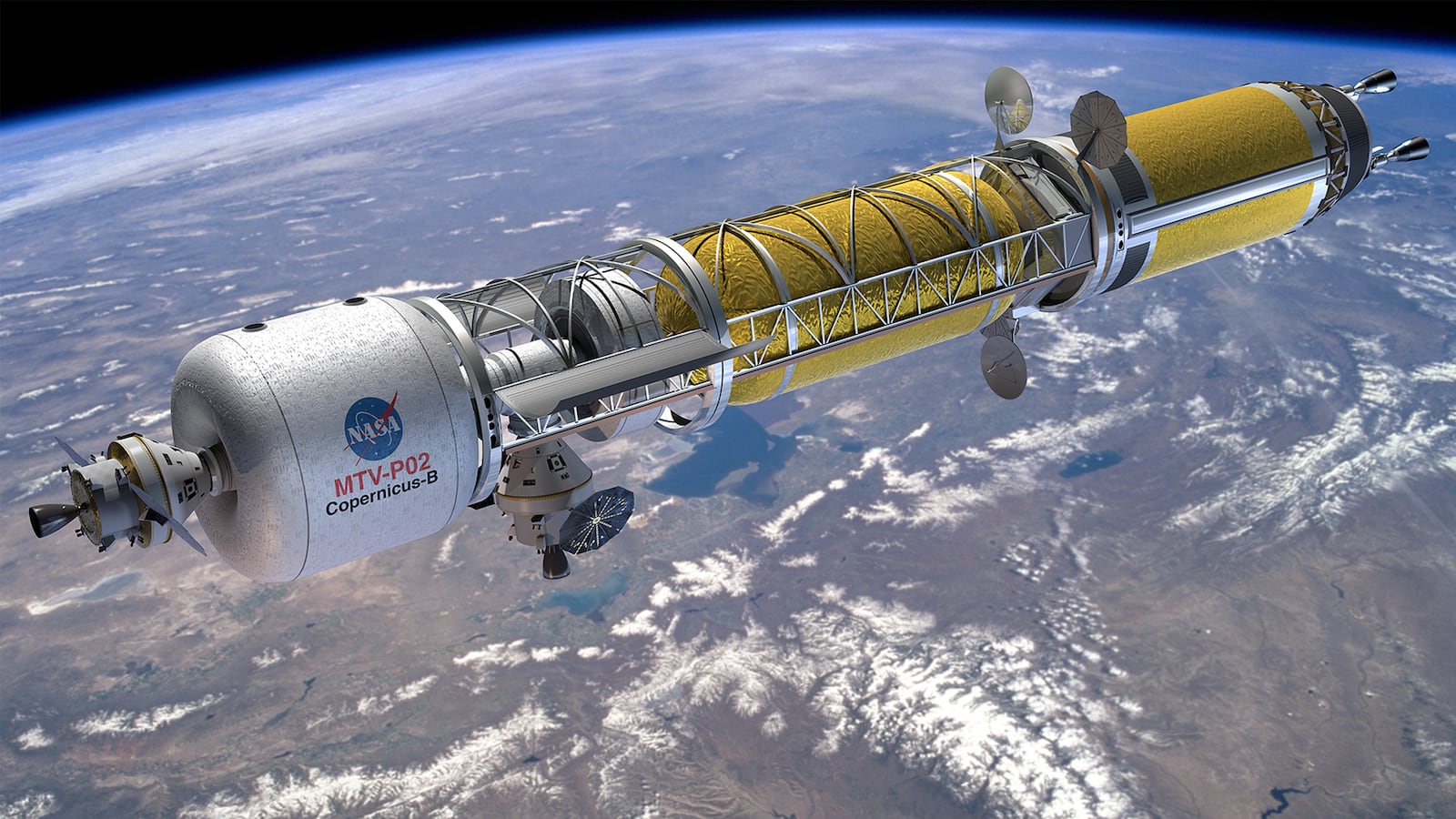The Pentagon wants to extend the reach of its satellites tens of thousands miles toward the moon. And it’s working on a high-tech, atomic-powered “nuclear thermal propulsion” engine to make it possible.
The military’s goal is to deploy maneuverable satellites into the vast space between the Earth and the moon—“cislunar” space, it’s called—before China gets there with its own spacecraft.
But this isn’t the first time the U.S. government has tried to develop an atomic rocket. And there’s no guarantee the same problems that ended previous efforts won’t also scuttle this one.
“The capability afforded by [nuclear thermal propulsion] will expand the operating presence of the U.S. in space to the cislunar volume and enhance domestic operations to a new high-ground, which is in danger of being defined by the adversary,” the Defense Advanced Research Projects Agency, which oversees the atomic rocket effort, explained in its budget proposal.
The U.S. and Chinese space agencies and even private corporations are eager to mine the moon for minerals that could support deep-space missions, potentially including humanity’s first trip to Mars.
“An agile nuclear thermal propulsion vehicle enables the [Defense Department] to maintain space domain awareness of the burgeoning activity within this vast volume,” Jared Adams, a DARPA spokesperson, told The Daily Beast.
DARPA’s budget request for 2021, which the agency released in early February, asks for $21 million for the “Demonstration Rocket for Agile Cislunar Operations” program, or DRACO.
Congress gave DARPA $10 million in 2020 to start studying the DRACO engine. The 2021 budget would allow the agency to start building components. The plan is for DARPA to test DRACO before handing it over to the U.S. Air Force for routine operations.
The military’s nuclear thermal propulsion project is a virtual twin of a similar NASA program that’s a couple of years older.
DRACO is what experts call a “high-assay low-enriched uranium nuclear-thermal propulsion system.” Basically, it’s a small nuclear reactor atop a space rocket. The reactor heats up a propellant—hydrogen, for example—that accelerates through a nozzle, pushing the satellite in the opposite direction.
Nuclear-thermal engines aren’t for launching from Earth’s surface. They’re for cruising long distances through space or maneuvering a lot while keeping closer to Earth.
The moon is 240,000 miles from Earth. Most man-made satellites orbit no more than a few thousand miles from Earth’s surface. The United States and China are both in a scramble to fill that gap.
Beijing in 2019 landed humanity’s first-ever probe on the moon’s difficult-to-reach far side, which always faces away from Earth.
Now the Chinese space agency is working on follow-on moon missions and could even send human explorers to the lunar surface as early as the mid-2020s.
NASA, meanwhile, has at the urging of President Donald Trump tried to accelerate a potentially $30 billion plan to build a new manned station in cislunar space. That would function as a staging base for U.S. astronauts to return to the moon by 2024, the theoretical final full year of a possible second term for Trump.
Atomic rockets could support America’s new moon push. You launch the pieces of the reactor into Earth orbit on top of traditional chemical rockets and then assemble them while they’re zooming thousands of miles per hour around the planet.
Attach the nuclear motor to a space capsule, spy satellite or orbital weapon, and it could travel huge distances over a span of years or even decades.
It was the long-distance potential that motivated early American efforts to build a nuclear thermal propulsion system back in the 1960s and ’70s. NASA was making progress when President Richard Nixon abruptly canceled a bunch of rocket programs in order to focus the space agency on arguably less ambitious missions.
Now the idea of a reactor on a rocket is back in vogue. “Compared to chemical propulsion systems, the performance advantages of NTP can enable shorter total mission times and enhanced flexibility for crewed Mars missions,” Clare Skelly, a NASA spokesperson, told The Daily Beast.
For the armed forces, nuclear thermal propulsion is “a way to get more maneuverability in their satellites—repositioning satellites chews through the onboard propellant of a satellite,” Dale Thomas, a space expert at the University of Alabama in Huntsville, told The Daily Beast.
Of course, civilian and military space funding are both subject to political whims. Just because the Pentagon and NASA want nuclear thermal propulsion systems today doesn’t mean the president and Congress will be equally enamored of the idea long enough to actually build them.
Congress has already begun to cool on Trump’s moon plan. Trump wanted $1.6 billion for the moon mission in the 2020 budget. Lawmakers approved $1.3 billion.
Plus there’s the issue of all that radiation. In the ’60s, NASA could test an atomic rocket in the desert, venting radioactive gas straight into the air, without too many people protesting. “That is not acceptable today,” Thomas pointed out.
The government could replace live testing with sophisticated computer simulations, Thomas explained.
The last time a human explorer set foot on the moon was in 1972 during the final U.S. Apollo mission. NASA hopes the current moon race results in a “sustainable” long-term human presence on or above the lunar surface.
The Pentagon wants to get there first with spacecraft that can keep an eye on… whatever arrives next.
To DARPA, that means building an atomic rocket. The agency surely hopes that, this time, it actually finishes building the thing.






